Kwei Quartey's Blog, page 10
October 21, 2014
THE EBOLA SAGA CONTINUES

THE CDC HAS LEARNED VERY QUICKLY THAT THEY NEED TO CHANGE
The Ebola story continues to unfold rapidly. In this post, a follow-up to my first article, I look at how the CDC and other US medical authorities have been learning their lessons–fast. The initial approach was somewhat cocky, i.e. Ebola “will never come to the USA,” but many have quickly learned their lesson.
In my follow-up piece written about 6 days ago and posted today, I point out some or the mistakes we made, but I am still not suggesting that Ebola will become an epidemic in this country, nor am I trying to whip up the already well-established hysteria that has been out of proportion to the facts. It still remains stunning that with THREE cases in the USA, compared to 10,000 plus in West Africa, the country has gone ballistic with shrill panic.
One aspect that has confused many are the words INFECTIOUS and CONTAGIOUS. “Infectious” means that a very small amount of virus or bacteria can cause illness–which is Ebola, or small pox, for example. “Contagious” refers to how easily it spreads–which is like influenza and NOT Ebola, because whereas I can sit 6 feet away from someone with the flu and catch it without even touching him/her, that doesn’t happen with Ebola. I have to get some kind of Ebola-infected fluid ON ME.
Read the latest post at FPIF.org and please leave any comments or questions you might have. I’ll do my best to answer them. Also let me know if you would like a review of the strange lingo of medicine, e.g. why is a NEGATIVE lab test a GOOD thing?
October 1, 2014
GOLD OF THE FATHERS
In the novel GOLD OF THE FATHERS (January 2016 release), Darko Dawson comes face to face with a world of which he had only passing knowledge: the world of small-scale, illegal gold mining. The first time he saw the wholesale devastation of land wrought in the quest for gold, he was stunned. Here are some of the scenes that he saw:
September 30, 2014
FROM IRENE TO BAGHDAD CENTRAL
Here is a nice review of crime fiction from all over the world. This is also very much in line with the international flavor of my publisher, Soho Press.
September 29, 2014
FIFTY AUTHORS TO WATCH IN 2014
Forensic Outreach, a publication I had not heard of before, has an interesting list of the top 50 best crime writers to watch for in 2014. They come from all around the world and I’m happy to see that a writer from Africa has been included.
Good stuff!
September 16, 2014
Win a free T!
Some nifty giveaways will be starting soon with purchase of my novel MURDER AT CAPE THREE POINTS.
For the period October, 1 – 31, 2014, the giveaway is one of these T-shirt designs:
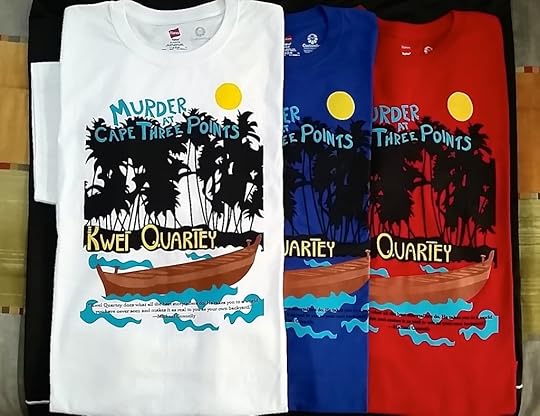
MAC3P T-SHIRTS: FULL COLOR, HANES THICK QUALITY MATERIAL
Remember, it starts October 1, not before. I recommend doing it this way:
1. Go to my page at Soho Crime’s website, http://bit.ly/1r6Gsst It has easy links for EPub, Amazon, Barnes & Noble, and IndieBound orders. No need to fumble around looking for my name/novels on the Internet.
2. You’ll get a confirmation of purchase like this:
3. Forward the order confirmation to me at kjoq@earthlink.net or info@kweiquartey.com, with your mailing address, your color preference and size. Each of the three choices is available in medium and large while supplies last.
4. Please be considerate enough not to cancel the book order to get your money back after you’ve sent me the confirmation. The T-Shirts and postage are all at my personal expense.
5. Limit one T-shirt per person per order. Supplies are limited. If you order two books, you still receive one T-shirt. If you get your mom, uncle or dog to also order the novel, they get one T-shirt per order as well. I’m not sure how well it will fit your dog but it certainly will get people’s attention.
6. If you prefer to buy my novel at a brick-and-mortar bookstore, that’s great as well. You can scan or photograph the receipt and email it to me from your computer or phone.
7. I will mail out the T-shirt to you as soon as possible. Please allow a reasonable time for delivery.
8. Bookstore owners and librarians are welcome to get a personal T as well!
Thank you.
June 8, 2014
WORLD MYSTERY TOUR: “C” is for CALIFORNIA–Part One
So many mysteries and thrillers are set in California. I will pick ones that are of note for one reason or the other, and my apologies for anyone that I might have omitted.
First, an acknowledgement to writers who have set their hardboiled fiction in Los Angeles. The hardboiled detective gets enmeshed in the crime and wickedness all around him, yet is still somehow detached from it. Any emotion is replaced by a tough, cynical attitude. One may argue which city is grittier, but I feel Los Angeles is the best hardboiled location. People move to LA to do their own thing, not to socialize. That is where the detachment comes from, and thus LA gives you hardboiled on a silver platter. In this vast metropolitan area (I live in Pasadena but still sometimes say I live in Los Angeles), you, the solitary driver in your car are surrounded by a sea of cars, all of them with their windows tightly shut. You are there and you look like you’re there, but in fact you are aloof from everyone, just like the hardboiled detective.
Prominent among hardboiled writers was Raymond Chandler (July 23, 1888 – March 26, 1959). One of the most quoted authors for his “Chandlerisms,” he had a strong influence on American popular literature, and is considered to be a founder, along with Dashiell Hammett, of the hardboiled school of detective fiction.

RAYMOND CHANDLER (Photo: telegraph.co.uk)
His famous protagonist, Philip Marlowe, has an office at #615 on the sixth floor of the Cahuenga Building on Hollywood Boulevard near Ivar, which is quintessential Hollywood (never to be confused with Beverly Hills). Years ago when I came to Los Angeles, Hollywood Boulevard was grungy and fading like a sad old movie star, and it was easy to imagine Philip Marlowe walking this street. But now, with the Dolby Theater, a huge glass-facaded Gap Store and other familiar chains, the boulevard is bright and glitzy but with less character than before.
Some of Chandler’s masterpieces are Farewell, My Lovely (1940), The Little Sister (1949), and The Long Goodbye (1953). I have not read everything Chandler wrote, but some of my most favorite lines are:
From The High Window–”He didn’t curl his lip because it had been curled when he came in…”
From The Big Sleep–“Such a lot of guns around town and so few brains…”
From The Long Goodbye–”She opened her mouth like a firebucket and laughed. That terminated my interest in her…”
It’s much harder to pull these lines off in twenty-first century writing, but some novelists can still do it, and we’ll take a look at one or two of them in upcoming “C is for California” blogs.
May 26, 2014
WHAT TO DO ABOUT “WRITER’S BLOCK”
I’m asked about writer’s block often enough at book signings. I’m never quite certain what the person’s concept of the phenomenon is, and personally I dislike the phrase. What is it? It could be the inability to decide where the story’s plot goes from a certain point, but Terry McMillan once said that it’s when the writer simply gets “bored,” and by that I assume she means bored with, or tired of, the story, which is like a death sentence for a writer.
I have never had “writer’s block,” for want of a better term. Let me modify that declaration: I have never had writer’s block on a story I am enjoying writing. Once I tried to write a novel with the German colonization of Ghana as the background. The opening scene saw a group of high-end Germans sitting around in a drawing room smoking cigars and drinking brandy. At the end of two pages, I realized I was stuck, but the real problem was I didn’t like the story, felt no connection with it, and hated the characters. It was a writer’s block in a way, but it was also my subconscious informing me that this was not a topic I was excited about writing.
Now in 2014, in a way I have come full circle in my third Darko Dawson novel, Murder at Cape Three Points, because Cape Three Points (CTP) is the area of Ghana that the Germans did briefly colonize, but now I was writing about it from a different perspective through the medium of a contemporary murder mystery, my undisputedly favorite genre.

CAPE THREE POINTS, “LAND NEAREST NOWHERE”–GHANA
(Image: ghanawestcoast.com)
Only a few kilometers away from CTP is the village of Akwidaa, where the nearby forest contains the ruins of the seventeenth century Fort Dorothea, one of the oldest forts in Ghana and a former trading post for the Brandenburg African Company. There is now very little to see of this fort and without preservation it’s likely to eventually crumble into nothingness.

RUINS OF THE FORT DOROTHEA (Photo: Kwei Quartey)
Just as I did, Darko Dawson visits these ruins with his wife Christine in the novel. So when I made that miserable attempt to write about German colonizers with whom I could not relate or about whom I did not care, I could not have known that the topic would resurface decades later in a different fashion: a relevant, relatable form in the context of which I would not come to a roadblock in my writing. Which is a roundabout way of saying:
First requirement for not encountering writer’s block: be sure you are writing something about which you care and feel excited. I don’t consider the maxim “write what you know” sufficient. I know medicine, but I’m not that drawn to writing a medical thriller. I’ll leave that to Robin Cook.
Second: Set it up right. The setup of the story should be like a coiled spring, the release of which propels all sorts of consequences and situations that complicate the story and demand solutions.
Third: Consider writing a synopsis. At first, I didn’t like synopses, priding myself in saying that I write cold and what happens happens, but now I find that they act as a roadmap to the final destination, reducing anxiety about “what’s going to happen next.” I think writers who decry synopses (and Terry McMillan is one) fear being constrained by the synopsis, but there’s no reason why that should happen. It’s like a journey from point A to B. You can leave the highway to stop in at a visitors’ center or coffee shop, but you still know where you’re going even though you hadn’t originally planned the detour.
Fourth: If you do get to a point where you feel like you’re stuck, don’t panic. These things have a way of sorting themselves out, especially if your setup is good. Sleep over it, and you might be surprised in the morning that you have a solution.
Fifth: If all else fails, consider doing the story over or abandoning it completely. I almost cringe to say the latter, but it’s better to abandon early than wrestle with it till late. This is one situation that a synopsis might obviate, because during the creation of the synopsis, you’ll have the opportunity to see what works and what doesn’t.
Happy writing.
May 14, 2014
DETECTIVES AND THEIR SIDEKICKS:FIVE THINGS YOU SHOULD KNOW
Holmes and Watson, Poirot and Hastings, Wolfe and Goodwin, Morse and Lewis, Lynley and Havers–these are some well-known detectives and their sidekicks in crime fiction. In contemporary times, Inspector Darko Dawson of Ghana’s Criminal Investigations Department (CID) has Philip Chikata. From my point of view, here are five tips for creating a believable detective and his/her sidekick.
The sidekick should never be more interesting or complex than the main detective. Remember Holmes’s bouts of depression, drug use and irascibility? Or Wolfe’s devotion to gourmet food and his episodic listlessness to the extent of being useless? The sidekick tends to be steadier in mood and temperament.
The main detective is ultimately cleverer than the sidekick, even if the sidekick comes up with something brilliant along the way. Sometimes the sidekick unwittingly gives the solution, but it takes the protagonist to recognize it.
The sidekick is a good sounding board, someone ideal for the protagonist to bounce off his ideas.
Rifts between detective and sidekick can occur, but keep them short. On the other hand, physical separation between the two that makes them wish they were together is great for tension.
Holmes sometimes deprecated Watson, which I suppose is okay for the great Sherlock, but there aren’t too many who can get away with that. Personally, I think it’s okay for the main detective to take his sidekick to task for an omission (especially in a police procedural), but humiliating his partner is unattractive. If that does happen, the protagonist owes his/her assistant an apology.
A bonus tip: a class clash between protagonist and sidekick is always interesting, as in Inspector Lynley’s relationship with Detective Sergeant Barbara Havers.
May 11, 2014
CRIME FICTION : WORLD TOUR “B” is for BOTSWANA
Botswana is notable for a number of reasons besides being the setting for murder mysteries. It’s a landlocked country in southern Africa (not to be confused with the country of South Africa).

LANDLOCKED BOTSWANA
(Image: Shutterstock)
With around two million people Botswana is the 144th largest country in the world by population and is roughly the size of Texas. About 70% of this country is Kalahari Desert. Botswana is well-known for its wildlife, and areas like the Chobe National Park, have high concentrations of game.

ORYX GAZELLES IN THE KALAHARI
(Photo: Shutterstock)

SUNSET-SILHOUETTED GIRAFFES IN KALAHARI DESERT
(Image: Shutterstock)
The economy of the country, dominated by diamond mining and tourism, is growing as rapidly as a brushfire in southern California, even though at independence from the British in 1966, Botswana was one of the poorest countries in Africa. It has a stable democracy, and has the second highest Human Development Index in sub-Saharan Africa.
Alexander McCall Smith
Soon after 9/11, Americans–and indeed, other nationalities worldwide–were looking for comfort. I was in New York soon after the atrocity, and in addition to the pervasive smell of acrid smoke, you could feel the omnipresent depression and see it in people’s faces. Everyone was casting around for comfort: comfort beverages, comfort food . . . and comfort books. One particular series of novels by Alexander McCall Smith was right there waiting to fill the role as comfort reading: The No. 1 Ladies’ Detective Agency series. People all over the world including in the US, took to McCall Smith’s book in their millions. BTW, I haven’t completely ascertained the connection with 9/11, but it’s a nice story, and I’m sticking to it.
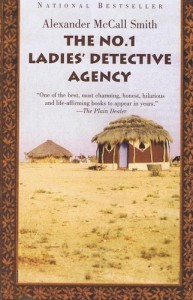
(IMAGE: AMAZON.COM)
Set in Botswana, the No. 1 Ladies’ Agency is located in Gabarone, the capital, and the first novel takes the same name as the series. Mma Precious Ramotswe is the first female private investigator in Botswana and the protagonist. She and the rest of the cast take what could be described as a whimsical approach to “mysteries,” such as disappearances, stolen items and extramarital affairs. There is something uniquely cozy and sweet-natured about this series, hence the comfort factor. Even the mystery in which a missing man turns out to have been swallowed by a crocodile has a certain benignity to it. Nevertheless, McCall Smith’s implied warnings about dangerous animals in Botswana are clear.
Alexander “Sandy” McCall Smith (“McCall” is not a middle name) was born in what was then Rhodesia and is now Zimbabwe. He became a Professor of Medical Law at the University of Edinburgh and a respected expert in medical law.
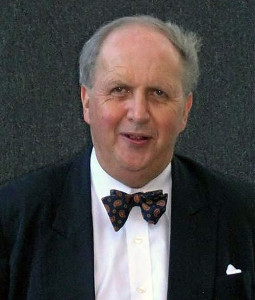
ALEXANDER MCCALL SMITH
(Photo: Tim Duncan)
Astonishingly prolific in both fiction and nonfiction, McCall Smith has published numerous other novels that are not in the No. 1 Ladies series. Personally he’s a rosy-cheeked and kind man with a tremendous and hearty laugh. At the 2013 Men of Mystery conference where he was headline speaker, he had all of the audience, including me, in stitches.
On publication of my first novel Wife of the Gods, a couple reviews made reference to the No. 1 Ladies series. Essence Magazine: “Like The No. 1 Ladies’ Detective Agency? You’ll love Wife of the Gods.” And The Wall Street Journal: “Fans of the No. 1 Ladies’ Detective Agency may have a new hero: Detective Darko Dawson.” If there was any intention to imply similarity between the two, it was misplaced, because in fact there is no similarity at all.
Michael Stanley
Another mystery writer to use Botswana as a setting is Michael Stanley, who is in fact two authors, Michael Sears and Stanley Trollip. Their hero is Detective Assistant Superintendent David Bengu of Criminal Investigations Department in Botswana’s capital Gabarone, which is a planned city built in the 1960s.

GABARONE SKYLINE
(Photo: Iulus Ascanius)
The first in Michael Stanley’s present mystery series, A Carrion Death, introduced us to the amply-sized David Bengu, affectionately called “Kubu” after both the size of the animal and his generally amiable nature with occasional ferocity.
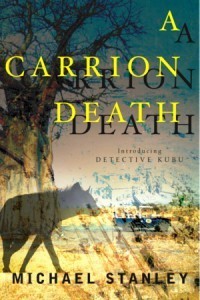
Image: http://jsydneyjones.wordpress.com
A Carrion Death was rewarded with excellent reviews and a highly favorable reception, including being nominated for a 2008 Barry Award in the Best First Novel Category. Since the first novel, Michael Stanley have published The Second Death of Goodluck Tinubu (one of the most intriguing titles for a book), Death of the Mantis, and Deadly Harvest, with a fifth one coming up soon. The authors are intimately involved in the online journal Murder is Everywhere, which features blogs from ten renowned international writers. Michael in particular has been very supportive of Darko Dawson and me, which I appreciate very much.
Real crime in Botswana
Crime is generally low in this beautiful country, and consists mostly of petty theft, but armed robbery, drug-related arrests and auto theft are reportedly on the rise. Home invasions are also reported, and these may be violent. Gun laws are very strict. A website, Fight Crime in Botswana is devoted to a community approach to counteracting and catching criminals. Despite all this, rest assured, as in many other African countries, the Batswana are friendly and hospitable. If you visit, just use the usual common sense you would exercise elsewhere.
May 4, 2014
CRIME FICTION:THE WORLD TOUR “A” is for Australia
Half of the most venomous snakes in the world are found in Australia. I share this piece of trivia because murder by snake has always intrigued me. To my knowledge, however, Australia’s top mystery writers haven’t featured death by snake in their novels. Yet. But if I’m mistaken, let me know. If not, feel free to steal the idea.
As an aside, I had one early version of Wife of the Gods in which someone not very nicely snuck a venomous snake into Darko Dawson’s bed to have him go to sleep forever–Darko, I mean, not the snake. Sub-Saharan Africa has its share of not very friendly serpents, including the Puff Adder, named for the blowing/puffing sound it makes when threatened or frightened. As a teenager in Ghana, I captured one that I discovered chilling in a corner on the back verandah of our home. Yes, I was a fearless, if not foolhardy, youngster. I might think twice about attempting that now–my snake-catching skills are a little rusty. If you want to see one of these awesome creatures puffing, I have a video at the end of this post, but fair warning: please don’t watch it if you’re already petrified of snakes.
Anyway, after that obviously self-serving digression, back to Australia. Garry Disher, published by Soho Press is the prolific and clearly brilliant author of over forty books for adults and children. Chain of Evidence, one of his novels, won the Ned Kelly Award for best Australian crime novel, but he’s won about a dozen different literary awards from all over the world. Disher sets much of his Inspector Hal Challis novels in Waterloo, a small town in the South West region of Australia. (At first I confused it with another Waterloo, a suburb of Sydney, but that’s the wrong one.)

BEAUTIFUL NATURALISTE PENINSULA, SOUTH WEST AUSTRALIA (Photo: Shutterstock)
But don’t be fooled by the smallness of Disher’s Waterloo, because Disher takes on everything from suburban sex rings to serial killing. PBS Masterpiece says, “Disher’s whodunits are dark and moody.”
Adrian Hyland writes his Emily Tempest series from Melbourne Australia, but many of his stories are set in the harsh conditions of the Outback and come highly acclaimed.

DRY, ARID CONDITIONS IN THE OUTBACK (Photo: Gnangarra, Wikipedia)
Moonlight Downs won the Ned Kelly Award for Best First Novel, and the NYT Book Review called it “Beguiling…wonderful.” Hyland spent many years in the Northern Territory living and working among the indigenous people. He now teaches at La Trobe University and lives in Melbourne.
Real crime in Australia
In 1996, a 28-year-old man, Martin Bryant, went on a shooting spree at the Port Arthur historic site in Tasmania, killing 35 people and injuring 23 others, the events unfolding in excruciating and horrific sequences at the Broad Arrow Cafe, the Gift Shop, the parking lot, a highway toll booth, a gas station, and along a roadway.
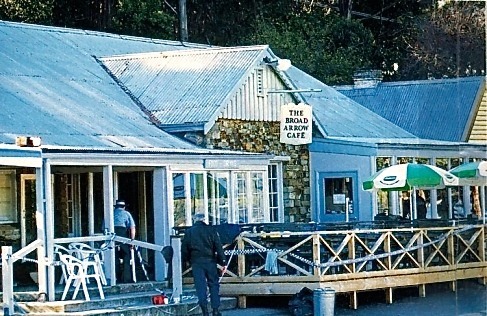
THE BROAD ARROW CAFE AT PORT ARTHUR (Photo: CriminalMinds.wikia.com)
Bryant is serving 35 life sentences plus 1035 years without parole, so there’s a good chance he won’t be getting out alive.

MARTIN JOHN BRYANT
(Photo: CriminalMinds.wikia.com)
Following this tragedy that gripped the country in disbelief and horror, under federal government co-ordination, all states and territories banned and heavily restricted the legal ownership and use of self-loading rifles, self-loading and pump-action shotguns, and heavily tightened controls on their legal use. The government initiated a “buy-back” scheme with the owners paid according to a table of valuations. Some 643,000 firearms were handed in at a cost of $350 million.
Up until Port Arthur, Australia had had multiple mass shootings. Since 1996, it has had none. This is of course the opposite of the US, where mass shootings lead logically to states relaxing gun laws so that people can logically buy more guns. Makes sense to me. And each month someone will predictably try to outdo the killing of last month, and we’ll wring our hands and gnash our teeth in anguish and have memorials, and then move on to the next gun-toting spectacle.
And now scroll down for that Puff Adder video if you’d like to see it. If not, don’t.




